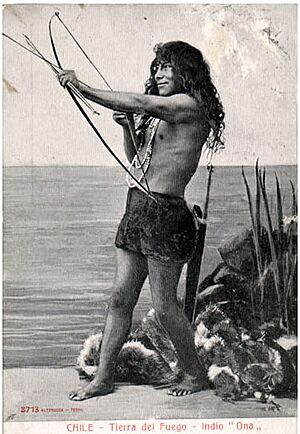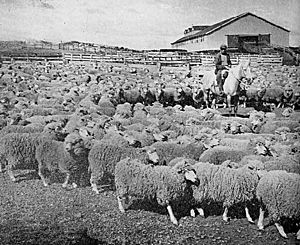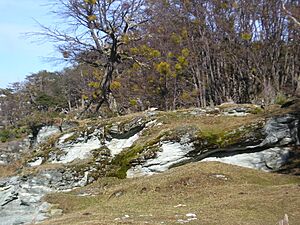Tierra del Fuego Province, Argentina facts for kids
Quick facts for kids
Province of Tierra del Fuego, Antarctica and South Atlantic Islands
Provincia de Tierra del Fuego, Antártida
e Islas del Atlántico Sur |
|||
|---|---|---|---|
| Province of Tierra del Fuego, Antarctica and South Atlantic Islands | |||
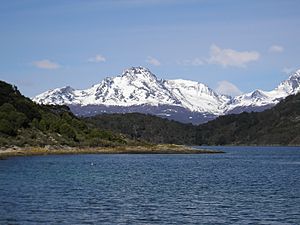
View from the Tierra del Fuego National Park in Argentina across the Beagle Channel to Isla Hoste in Chile
|
|||
|
|||

Location of Tierra del Fuego Province within Argentina
|
|||
| Country | |||
| Capital | Ushuaia | ||
| Departments | 5 | ||
| Local Governments | 3 | ||
| Area | |||
| • Total | 21,263 km2 (8,210 sq mi) | ||
| Population
(2022 census)
|
|||
| • Total | 190,641 | ||
| • Rank | 24th | ||
| • Density | 8.96586/km2 (23.2215/sq mi) | ||
| Demonym(s) | fueguino | ||
| Time zone | UTC−3 (ART) | ||
| ISO 3166 code | AR-V | ||
| HDI (2019) | 0.852 Very High (10th) | ||
Tierra del Fuego (which means "Land of Fire" in Spanish) is officially called the Province of Tierra del Fuego, Antarctica and South Atlantic Islands. It is the southernmost, smallest, and least populated province in Argentina.
People have lived in this area for over 12,000 years. The first European to see it was Ferdinand Magellan in 1520. Even after Argentina became independent, local indigenous people controlled this land until the 1870s. Argentina then made it a territory in 1885. Many Europeans moved here because of a gold rush and the growth of sheep farms. Tierra del Fuego became a province in 1990, making it Argentina's newest province.
Contents
What Areas Does Tierra del Fuego Cover?
The main part of the province is the eastern side of the island of Tierra del Fuego, plus Isla de los Estados and other nearby islands.
The province also officially claims the Falkland Islands and South Georgia and the South Sandwich Islands. These are currently British territories. Argentina also claims a part of Antarctica, which overlaps with claims from Britain and Chile. Argentina only controls its own research bases in Antarctica.
A Look at Tierra del Fuego's History
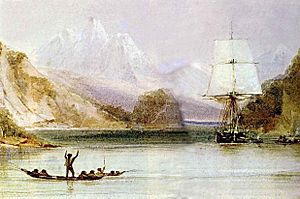
Tierra del Fuego is the newest of Argentina's provinces. People first lived here about 12,000 years ago. When Europeans arrived, there were about 10,000 indigenous people from four main tribes: Yámana, Alakaluf (also called Kawésqar), Selk'nam (Ona), and Manek'enk (Haush).
Sadly, within 50 years of the Europeans arriving, only about 350 native people remained. Many died from diseases like smallpox and measles that Europeans carried, as the native people had no protection against them. Also, in the late 1800s, ranchers and settlers caused terrible harm to the Selk'nam people. The capital city, Ushuaia, gets its name from a native word meaning "bay towards the end."
Europeans first saw this land in 1520 during Ferdinand Magellan's trip. He called it "Land of Smokes" because he saw fires, likely made by the local Amerindian people for warmth. Later, the name was changed to "Land of Fire."
Spanish, Dutch, British, and French explorers sailed around Tierra del Fuego and its nearby waters. In the early 1830s, Commander Robert FitzRoy and Charles Darwin explored this area and other parts of Patagonia on the ship HMS Beagle.
In 1828, Argentina set up a prison colony on the Falkland Islands. In 1833, the British sent ships and took control of the islands again.
Luis Piedrabuena set up a base on Isla de los Estados. In 1869, the South American Mission Society Patagonia Mission started Ushuaia as a Christian mission. Soon after, Salesian missionaries founded Río Grande.
In the 1880s, the Argentine government became more interested in Tierra del Fuego. In 1881, a line was drawn to divide the island between Chile and Argentina. In 1884, the "Government of Tierra del Fuego" was created, and Ushuaia became an important town.
The southern part of the Beagle Channel was a point of disagreement between Argentina and Chile, especially over three small islands: Picton, Lennox and Nueva. In 1977, a British decision gave these islands to Chile, and this was confirmed by Pope John Paul II and a treaty in 1985.
Many people thought Tierra del Fuego was a very harsh place to live because of stories about dangerous sea voyages around South America. However, it is not the least populated province in Argentina. Its population density is higher than five other provinces, thanks to different groups of immigrants who have moved there over time.
Around 1883, a gold rush began in Tierra del Fuego. Many people from Croatia came looking for gold. The gold rush also led to new inventions like the telegraph. Even though the gold ran out by 1910, most of the pioneers stayed. The flat northern plains were perfect for sheep farming, and large ranches were built. Immigrants from Croatia, Scotland, Basque Country, Italy, Galicia, and Chile came to work on these ranches, hoping to buy their own land one day.
The native people suffered greatly from diseases and conflicts with ranchers. By 1920, their population on the island had dropped to only 200. News of these terrible events reached the Federal Congress in Buenos Aires. They sent help and tried to support the Salesian mission, which was the only group working to protect the indigenous peoples on the island.
In 1943, the "Maritime Government of Tierra del Fuego" was created. This led to the building of naval bases in Ushuaia and Río Grande, along with an airport and other important structures. These projects attracted immigrants from other countries and other parts of Argentina.
Finally, in 1990, the "National Territory of Tierra del Fuego, the Antarctic and the South Atlantic Islands" became a province. Its first governor was chosen two years later.
What is the Geography and Climate Like?
In the north of the island, you'll find low mountains and sandy beaches. As you go south, the land gets higher. The northern part is similar to the flat, dry lands of Santa Cruz Province. In the middle of the island, the Andes mountains become flatter. Their highest point, Mount Cornú, is only about 1,490 meters (4,888 feet) tall.
There are several short rivers, like the Grande and Moneta. Because it's so cold, there are also many small glaciers that flow into the sea.
Due to its location far south, the island has a cold oceanic climate. The ocean and strong winds from the west make the weather very similar across the whole province. Average yearly temperatures are low. In winter, temperatures are around 0°C (32°F), and in summer, they are about 10°C (50°F). Strong westerly winds from the Pacific Ocean make it feel even colder. In the far south, in the Beagle Channel, winds can be stronger than 100 kilometers per hour (62 miles per hour).
The island gets about 700 millimeters (28 inches) of rain each year, spread out fairly evenly. Snowfall is common across the island. Much of this island is covered by Magellanic subpolar forests.
How is Tierra del Fuego Governed?
The government of Tierra del Fuego province has three main parts:
- The executive branch is led by a governor, who is chosen by the people. The governor then picks a team of advisors called a cabinet.
- The legislative branch makes the laws.
- The judiciary branch includes the Supreme Court and makes sure laws are followed.
The rules for how the province is run are written in the Constitution of Tierra del Fuego Province, Argentina.
The main police force in Argentina is the Argentine Federal Police. However, the Tierra del Fuego Provincial Police also helps keep the peace in the province.
What are the Administrative Divisions?
The province is divided into five areas called departamentos (departments). Only the first three are actually controlled by Argentina:
- Ushuaia (its main town is Ushuaia)
- Tolhuin (its main town is Tolhuin)
- Río Grande (its main town is Río Grande)
- Islas del Atlántico Sur: This includes Argentina's claim to the Falkland Islands (called Malvinas in Spanish) and South Georgia and the South Sandwich Islands. These are currently self-governing territories of the United Kingdom.
- Antártida Argentina: This is Argentina's claim to a part of Antarctica. It overlaps with claims from Chile and Britain. This area has no permanent residents, only staff at scientific bases. Because it is south of 60°S, Argentina's claim to this area is paused under the Antarctic Treaty.
What is the Economy Like?
Since the 1970s, Tierra del Fuego has received help from the government for its industries and has benefited from its natural resources. In 2006, the province's economy was worth about US$2.6 billion. This meant that each person in the province earned about US$25,719, which was the second highest income per person in Argentina.
Even though the province is far away, manufacturing (making things in factories) makes up about 20% of its economy. This is partly because the government offers tax benefits to local businesses. This policy helps encourage people to move to less populated areas. Many factories, especially those making home appliances and electronics, have opened on Tierra del Fuego Island to take advantage of these tax breaks.
Recently, in the city of Río Grande, companies like Samsung (from Korea) and Teltron (from Argentina) have set up factories. They make high-definition televisions (HDTV), CD-ROM related products, and affordable GSM cell phones, mostly using parts made in Argentina.
Sheep farming is the main source of income from agriculture in the province, though it's a small part of the overall economy (5%). Sheep provide wool, meat, and hides for the province and for the rest of Argentina, where demand for these products is growing.
Just like in Patagonia to the north, getting petroleum (oil) and natural gas from the ground is very important to Tierra del Fuego's economy. It makes up over 20% of the total economic output. Companies are still looking for more oil and gas. The government of the Falkland Islands has also given out licenses for oil exploration in its waters, which has caused some tension with Argentina. This activity has also affected the profitable crab and shrimp fishing industry in the area.
Tourism is becoming more important on Tierra del Fuego island. The region offers mountains, glaciers, forests, fast rivers, waterfalls, and ski centers (the most famous being Cerro Castor). All these attractions are close to the sea.
The most popular places to visit in Argentine Tierra del Fuego include Ushuaia, the Tierra del Fuego National Park, the Tren del Fin del Mundo (Train to the End of the World), Fagnano Lake, the Museum of the End of the World, the Beagle Channel, the Les Eclaireurs lighthouse, the old jail, and South Staten Island.
The Antarctic Peninsula is also a tourist spot. Visitors can see wildlife at the Argentine Marambio Base during the summer.
Images for kids
-
Governor's offices in Ushuaia.
-
The Les Eclaireurs Lighthouse, near Ushuaia.
-
Cerro Castor is the most important ski resort in the province.
See also
 In Spanish: Provincia de Tierra del Fuego, Antártida e Islas del Atlántico Sur para niños
In Spanish: Provincia de Tierra del Fuego, Antártida e Islas del Atlántico Sur para niños





